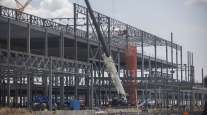Navistar Loses $172 Million in 2Q, Citing Engine Certification ‘Distraction’
This story appears in the June 11 print edition of Transport Topics.
Navistar International Corp. last week reported a $172 million loss in its second quarter, partly triggered by what its top executive said was “a lot of noise and speculation” about Environmental Protection Agency approval of its 13-liter engine, and reshuffled top management in a bid to restore profitability.
The results for the quarter that ended April 30 reversed a $74 million profit in the prior-year period. The company said revenue fell 1.7% to $3.3 billion. Last quarter, the heavy-duty truck, bus and engine maker had a $153 million loss.
Troy Clarke was named president of truck and engine, a newly created post, with oversight of those businesses, as well as parts, product development and purchasing. His current post is president of Navistar Asia Pacific.
Navistar, Lisle, Ill., said its quarterly results also were hurt by higher warranty costs, lower military and overseas sales and a slim profit in its core North American truck market.
While Chief Executive Officer Daniel Ustian didn’t specify how much the EPA-related uncertainty hurt the results, he did promise to improve second-half performance with a pickup in sales, revenue and profit.
“We have to get this EPA thing behind us,” Ustian said. “I don’t think there is any question it is a distraction for the senior management.”
Navistar’s 13-liter engine meets EPA 2010 standards only by applying credits it accrued through selling other engines with emissions that were better than EPA standards. Navistar has agreed to pay a penalty for selling noncomplying engines and in February submitted a retuned 13-liter unit to EPA with the goal of meeting the required emissions levels.
Navistar said it resubmitted its approval application for the 13-liter engine to EPA on May 21 and is currently doing tests on what Ustian described as modifications requested in “some spots” on the engine. He didn’t elaborate, and the company declined to provide further detail.
Ustian also said that he expected the review period for the May submission to be shorter than the three to four months he forecast when its original application for the engine approval was submitted in February.
Excluding warranty, emissions penalties and restructuring costs, Navistar calculated that its manufacturing business had a $7 million profit, including $43 million in North American truck profit, and losses in global, defense and engine and parts businesses.
The company outlined an anticipated second-half improvement, also excluding the same costs, to a manufacturing profit totaling between $575 million and $725 million.
“For us to achieve those goals, we have to have those [EPA] approvals,” Ustian said on a conference call.
In addition to the engine approval, Ustian said the targets would be achieved by a combination of stronger sales in line with a traditional second-half pickup in business and cost reductions that boost profit margins.
Navistar now expects second-half revenue to range between $7.8 billion and $8.4 billion.
The company also forecast it will gain market share to as much as 22% of the North American Class 8 market in the second half of the year, compared with 18% in the second quarter.
Navistar’s new corporate structure changes its traditional division between truck and engine production, consolidating its truck and engine businesses under Clarke.
Jack Allen, who has been president of the North American truck group, was named president of North American truck and parts, while Eric Tech, current president of the engine group, will become president of global truck and engine to cover all activities outside North America.
Dee Kapur, currently truck group president, Navistar Inc. will become chief product officer, responsible for research and development, and still reporting to Ustian.
Navistar’s statement said the moves will be effective on July 1 after its board approves.
“I am confident that our new management structure will lead to greater planning and execution . . . deliver enterprise-wide profitability, leverage assets more effectively . . . and bring renewed energy to our team,” Ustian said in a statement.
In light of the latest loss, Navistar cut its full year profit forecast to a range of zero cents per share to $2, from the estimate in March of $4.25 to $5.25 per share.
The March estimate itself had been lowered from a late 2011 projection that profit in the current fiscal year could reach up to $5.75 per share.
Investors pounded the company’s stock after the announcement, resulting in a one-day drop of $4.04 per share, or nearly 14%, the steepest in the past several years.
Navistar reported $104 million in warranty reserve costs for engines made in 2010 and early 2011, $10 million in penalties for selling engines that didn’t meet EPA standards and another $67 million in total for asset impairment and engineering costs.
Ustian said the warranty-related costs are expected to decline in the coming quarters, without saying by how much.




